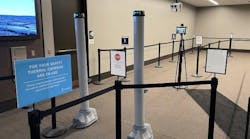Screeners failed to find most of the fake bombs smuggled by plainclothes investigators through checkpoints at two major airports from late 2005 until last fall, the Transportation Security Administration said Thursday.
Investigators successfully smuggled 75 percent of the fake bombs through checkpoints at Los Angeles International Airport in California, and 60 percent through Chicago's O'Hare International Airport in Illinois, according to a report obtained by USA Today. In tests at California's San Francisco International Airport, where a private company conducts inspections, 20 percent of the contraband made it through security.
The TSA confirmed the results but said the tests, conducted in fiscal year 2006, prompted the agency to change its protocols. Taking a cue from the experiences in San Francisco, the TSA now conducts daily testing, which has led to improvements at airports across the country, the agency said.
The agency conducts 2,500 tests a day nationwide, said spokeswoman Ellen Howe. "There are tests literally in every lane, every shift, every day," she said. The TSA does not release test results, but she said the increased tests have shown an overall improvement.
The agency's Office of Investigations conducted the tests in question from October 2005 to September 2006, Howe said. Investigators posed as passengers, concealing fake bombs, bomb components and weapons in their clothing and carry-on bags as they went through security screening.
The TSA conducted about 70 tests in Los Angeles, 75 in Chicago and 145 in San Francisco.
The government has conducted similar testing in the past, with similarly poor results. Repeated tests by the Department of Homeland Security's Office of Inspector General led the Government Accountability Office to conclude that better technology would improve security.
The TSA said it's working to deploy improved machinery such as X-ray machines that can better distinguish between harmless objects and bombs. However, the agency also has worked to emphasize the search for bomb components, said TSA Administrator Kip Hawley.
Some 30,000 screeners, renamed as transportation security officers, underwent training in fall 2005 to detect such components. The TSA chief also increased weekly training from three to four hours, Howe said.
San Francisco's practice of continuous testing has become the norm, Howe said. With constant testing, it becomes second nature to find components, she said. "We have to keep challenging screeners; we have to keep changing it up," she said.
In the past, San Francisco screeners were criticized when it was learned they had advance warning of the testing and used the airport's security cameras to follow investigators to checkpoints.
More recently, Richard L. Skinner, the Department of Homeland Security's inspector general, disclosed that screeners at Jackson-Evers International Airport in Mississippi had advance notice of tests in 2004, and were given descriptions of undercover investigators and the type and location of items to be sneaked through checkpoints.
Skinner said he's expanding his probe of possible cheating to include other, unnamed airports.
In addition to the physical tests of airport checkpoints, the TSA uses "threat image projection," which digitally inserts images of "threat objects" such as knives and bomb parts into X-ray machine images of passengers' bags. The system is intended to train screeners and keep them alert.


